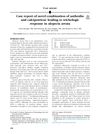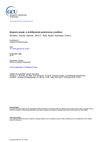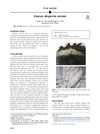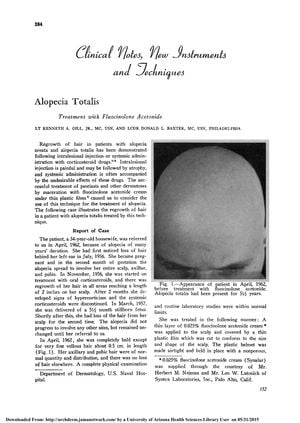TLDR A woman regrew her hair significantly using a corticosteroid cream with a plastic cover.
A 34-year-old woman with alopecia totalis of 5 years duration experienced significant hair regrowth after being treated with 0.025% fluocinolone acetonide cream under an occlusive plastic dressing. The treatment involved applying the cream and covering it with a plastic film for 48 hours every 72 hours. After 3.5 months, her hair grew to 3 cm, and by September 1962, it reached 5 cm with normal texture and color. The patient showed no systemic side effects, and the treatment's success suggests that the corticosteroid acts locally, possibly facilitated by the occlusive dressing.
15 citations
,
June 1961 in “Archives of Dermatology” Triamcinolone can regrow hair in alopecia areata, but the effect is temporary.
57 citations
,
December 1960 in “Archives of Dermatology” Steroid injections can help regrow hair in some alopecia cases.
 6 citations
,
March 2019 in “JAAD case reports”
6 citations
,
March 2019 in “JAAD case reports” A new mix of anthralin and calcipotriene might help treat severe hair loss.
 148 citations
,
December 2018 in “Journal of autoimmunity”
148 citations
,
December 2018 in “Journal of autoimmunity” Alopecia areata is an autoimmune disease causing patchy hair loss, often with other autoimmune disorders, but its exact causes are unknown.
 4 citations
,
November 2018 in “JAAD case reports”
4 citations
,
November 2018 in “JAAD case reports” Alopecia areata can sometimes appear as a straight line of hair loss instead of round patches.
May 2018 in “Journal of cosmetology & trichology” Combining platelet-rich plasma therapy with prostaglandin-F eye drops can significantly regrow hair in alopecia universalis.
110 citations
,
December 2013 in “The journal of investigative dermatology. Symposium proceedings/The Journal of investigative dermatology symposium proceedings” Alopecia areata is a genetic and immune-related hair loss condition that is often associated with other autoimmune diseases and does not typically cause permanent damage to hair follicles.



